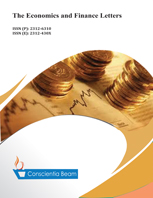Deficit Financing Asymmetry and Nigerias Economic Growth: A Nonlinear Autoregressive Distributed Lag Approach
DOI:
https://doi.org/10.18488/journal.29.2020.72.112.121Abstract
This study examine deficit financing asymmetry and Nigeria’s economic growth using time series quarterly data covering the period of 2000 to 2019. The study is hinged on Keynesian, Monetary Neo-Liberal theoretical postulations to ascertain the asymmetry and significance relationship between deficits financing and Nigerian economy. The study applied Non-Linear Autoregressive Distributed Lag (NARDL) technique. The estimated NARDL model reveals that both positive and negative deficits financing innovation reduces economy growth; however, the impact of negative deficit financing innovation is greater than the positive innovation. In addition, the Nigerian economy is also driven by weak institutions and low level of savings culture, which is evidence in negative signs of both coefficients of savings and quality institution. This study therefore lend support for fiscal governance through review of laws that made the existing institutions and further strengthen in line with global best practice to guide and monitor the implementation of deficit financing in investment-oriented projects that can translates to better standard of living of the citizenry.

